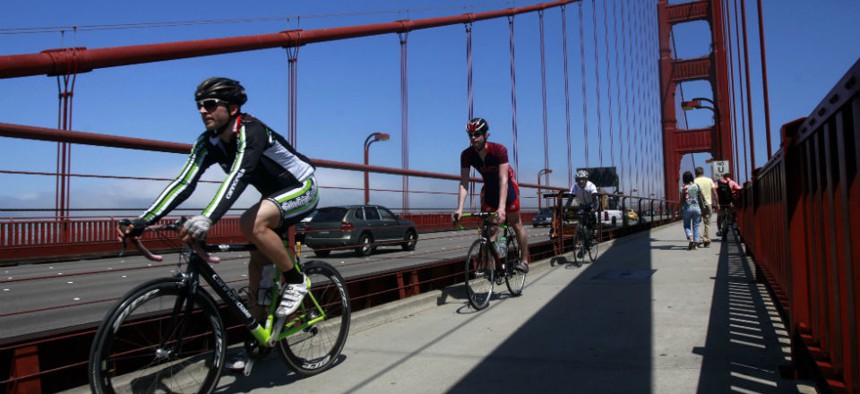
Bicycilists drive south as they cross the Golden Gate Bridge on Bike To Work Day in San Francisco. Jeff Chiu/AP File Photo
The Complete Guide to Biking to Work
If you’ve decided to join the bike pack, congratulations. You’ll probably be healthier, happier, and save money on your commute.
Whether you live in a small, mid-size, or large city, chances are it’s becoming easier to bike to work. If the proliferation of bike-sharing programs around the world is an indicator, then cycling is having a moment.

Despite the danger of getting hit by a car, recent research suggests that the health benefits of cycling far outweigh the risks of getting into an accident. In the US, bicycle deaths hover at around 2% of total motor vehicle fatalities (pdf).
If you’ve decided to join the bike pack, congratulations. You’ll probably be healthier , happier , and save money on your commute .
Bike-sharing has existed since the 1960s, but it wasn’t until Paris installed its popular Vélib’ program in 2007 that mayors around the world started clambering for bike-share programs of their own. Since then, nearly 600 cities have installed bike-share programs, with a combined fleet of over 570,000 shared bikes.
With those bike sharing programs come better infrastructure for bikers, including bike lanes. Here are some tips for those new to the bike commute:
To share or to own
Owning a bicycle drastically changes your daily routines. A bike share relieves you of hauling your bike up and down the stairs, regularly taking it in for maintenance, worrying about theft and vandalism. If you want to keep your relationship with bikes casual, the bike share is your best choice, and annual memberships are typically under $100.
On the other hand, shared bikes are typically heavy and slow, and they’re only convenient if you live near a drop-off point. If you are thinking about getting serious about commuting, it’s probably cheaper to buy a bike in the long run. A decent aluminum frame road bike shouldn’t cost more than $400 , and will last around four to six years .
When to ride
The National Highway Traffic Safety Administration has found that most fatal accidents happen between 4pm and midnight (pdf, page 2). Another benefit of joining a bike share is that you can always skip the evening commute and take public transportation instead, avoiding a time when people on the road (yourself included) are more likely to be tired or intoxicated.
Safety first
It might seem like wearing a helmet when you bike is a no-brainer, but some have argued that doing so is actually more dangerous than going bare-headed.
Opponents of helmet laws point to Northern European cycle-heavy cultures such as Denmark, the Netherlands, and Germany, which have both low rates of helmet-use and of cycling-related head injuries. Several large cycling associations, notably the European Cyclists Federation and the CTC in Great Britain, oppose helmets. This camp argues that helmets make cyclists more prone to dangerous behavior, make cycling seem like a dangerous activity, put the burden of an accident on the rider, and (because they are unstylish) discourage people from bicycling.
However, no major health organizations have endorsed this view. In fact, most global and national health organizations promote helmet use. And no studies have proven that Northern Europe’s low head-injury rates are due to the lack of helmets.
In short, you’re better off wearing a helmet. And no, it doesn’t have to be hideous .
You can buy a pair of reliable, USB-rechargeable, front and rear LEDs from Bontrager for around $60. There are plenty that are cheaper ( and plenty more expensive ), but most quality light sets are going to hover around the same price point.
Still, front and rear lights aren’t particularly effective at making bikes visible to drivers at upcoming intersections. To that end, a London startup called Blaze has made an LED that projects a bicycle onto the street in front of you.
What to wear
Biking to work can be sweaty business. To keep from showing up at work looking disheveled, you’ll want to pack a change of clothes in a bag.
Po Campo has a bag specifically made for bike shares . It’s roomy enough for a laptop, a nicely-folded change of clothes, and maybe even a pair of shoes. If you own a bike, consider panniers (a bicycle version of saddlebags). You’ll have to install a rack, which will cost you anywhere from $30 to $100. (The Thule Pack n’ Pedal , for $100, is durable and easy to install and remove.) For hauling your gear, Ortleib makes a waterproof roll-top bag that doubles as a backpack for around $90 .
How to ride
Sticking to bike lanes seems like the obvious advice, but not every route has continuous bike-lane coverage. And even if there is space set aside for bikers, there are several different types of lanes, each with different best strategies for safe riding.
If there is no lane, you are probably best sticking to the principles of vehicular cycling , a riding philosophy that was invented in the 1970s that encouraged cyclists to be assertive about their right to the road. According to John Forrester, who pioneered the practice, 95% of all cycling accidents happen when a car or bike crosses traffic or turns.
It might be instinctual to huddle close to the edge of the road, but this just makes you less visible to cars. Riding several feet from either the curb or parked cars on the side of the road will make you more visible to drivers, and will reduce your chances of getting clipped by a turning vehicle. For similar reasons, if you are riding in a bike lane, stay closer to the traffic side of it. This also gives you more time to react when a car pulls out, a pedestrian appears between parked vehicles, or a dreaded car door opens.
To decrease your chances of getting side swiped, stop at red lights and stop signs . Equip your bike with a bell to warn pedestrians you are coming, or other cyclists if you are overtaking them . If you live in a city where motorists seem particularly oblivious to cyclists, you can even invest in this $95 horn that sounds like a honking car.
Reprinted with permission from Quartz . The original story can be found here .
NEXT STORY: No, the VA Is Not an Obamacare Preview







